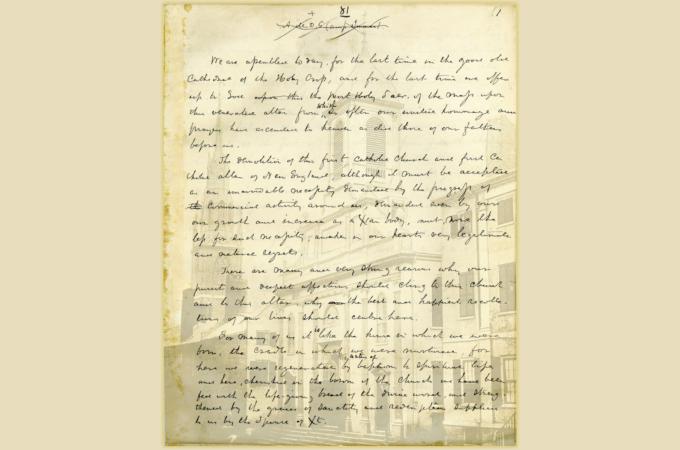The final Mass of Boston's original cathedral
On Sunday, Sept. 16, 1860, the Cathedral of the Holy Cross on Franklin Street in Boston was filled to capacity, while many more would-be worshipers lingered on the sidewalks outside. The reason so many gathered was to witness the final Mass at what was New England's first Catholic Church, dedicated by Bishop John Carroll almost exactly 57 years previously, in September 1803, and, since 1808, the spiritual center of the Diocese of Boston.
Bishop John B. Fitzpatrick, the celebrant, prepared an address but, so moved by the occasion, was unable to deliver it himself. Instead, he delegated the task to the chancellor of the diocese, Father James A. Healy. His words were reprinted in The Pilot of Sept. 22, 1860, and his original handwritten text resides in the archdiocesan archive.
Bishop Fitzpatrick begins by reflecting upon the present situation, admitting the demolition of the cathedral was "an unavoidable necessity, demanded by the progress of commercial activity around us, demanded even by our own growth and increase as a Christian body." The composition of the neighborhood around Franklin Street had changed drastically since 1803, with fewer families living in the immediate area, their homes replaced by businesses. He also alludes to the growth of the Catholic population, by this time drastically increased through primarily Irish immigration. Even so, he admits, the event must "awaken in our hearts very legitimate and natural regrets."
His sadness may not be for the building itself, the bishop continues, but what it represents. "The Cathedral of the Holy Cross was the work of a very little band of Catholics," he states, "whose only resources were their faith, their piety, their brotherly union and their trust in God." He reflects that these early Catholic pioneers, led by then Father John Cheverus and Father Francis Matignon, forged a Catholic community and church from what little they could offer, and it is symbolic of their achievement.
Bishop Fitzpatrick then calls upon those present to honor the legacy of their predecessors. Though the current cathedral would be vacated, "another, under the same sacred title, the same holy banner, must take its place, and to erect this other is our work. What, therefore, can we do better than to emulate their example." Their means cannot compare, he continues. Those before counted their number by the individual, and now they count by the hundred or thousand.
Finally, he concludes, "let us implore the bestowal of Divine grace upon all and every one of us that no one may depart from this altar to-day without the resolution of laboring for the beauty of God's house, and of co operating [sic.] generously and preserving for the erection of a new Cathedral of the Holy Cross."
It was intended that the sale of the Franklin Street cathedral would provide the means for beginning construction of a new cathedral in Boston's South End, but the election of Abraham Lincoln as president and ensuing civil war delayed any plans that had been prepared. Instead, it would be left to Bishop Fitzpatrick's successor, Bishop John Williams, to complete the task. Enough of the structure would be completed for Bishop Williams to be installed as Boston's first archbishop within its walls in May 1875, and the completed structure was dedicated the following year.
As Bishop Fitzpatrick considered the Franklin Street cathedral as a symbol of the past, the new cathedral very much symbolized what the archdiocese was and would be in the future. Its grand size and adornments reflected the growing community, fueled primarily by Irish immigration in the 19th century, and soon those from Poland, Lithuania, Italy, Portugal, and countless other places into the early 20th century and through today. The successful completion of the Cathedral of the Holy Cross and its continued place as the spiritual home of Boston's Catholics has hopefully fulfilled the wish of Bishop Fitzpatrick, and honored the legacy of those founding members of the community and its first cathedral.
- Father Thomas Ryan, CSP, directs the Paulist North American Office for Ecumenical and Interfaith Relations in Boston.



















